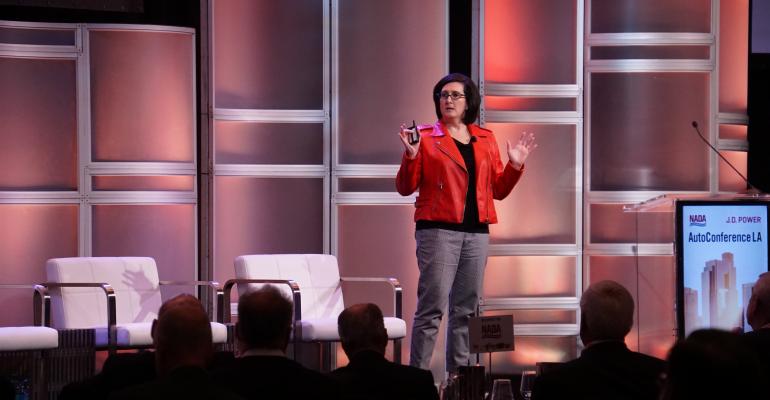LOS ANGELES – Dealers shouldn’t do certain things on a test drive, lest they freak out customers.
So says Kristin Kolodge, J.D. Power’s executive director-driver interaction and human/machine interface, while promoting the need for consumers to understand the advanced technology in their vehicles, but without experiencing the trauma of a real-world demonstration.
One no-no she cites is to show how automatic emergency-braking works by putting customers driving a demo car in a tight traffic spot and telling them, “Don’t brake.”
That may show the wonders of collision-avoidance systems, but it may also stress out the driver. Without going to such extremes, “get creative with explaining technology,” Kolodge says.
That’s because when dealers take time to do that, customer satisfaction increases, she says. “When consumers understand the technology, they will use it on a day-to-day basis.”
Yet the in-store delivery of a vehicle to a buyer should not turn into a protracted technology tutorial. “It is not reasonable to explain everything,” Kolodge says.
Some dealers who take time to explain the technology end up doing what amounts to double vehicle deliveries, says Peter Hoffman, president of Sierra Autocars, a dealership group based in Monrovia, CA.
The first delivery traditionally includes salespeople congratulating customers on the purchase of their shiny new vehicle, handing over the keys with a handshake and a smile and sending them merrily on their way.
The second delivery involves customers later returning to the dealership “and learning about the advanced technologies on the vehicle,” Hoffman says. Tech-savvy staffers can help out there. So can demonstration videos.
Kolodge and Hoffman at a J.D. Power/National Automobile Dealers Assn. automotive conference here discuss the need and benefits of familiarizing customers of today’s vehicle-safety systems, from lane-keeping assistance to adaptive cruise control to emergency stopping.
“People look to dealers to inform them,” Hoffman says.
Kolodge adds, “Make sure their first experience with these technologies is a positive one, in that when they drive off the dealer lot and hear that first chime or beep, they’ll know what it means.”
She calls adaptive cruise control a marketplace hit. The system uses radar to automatically adjust vehicle speeds to maintain a safe distance from the vehicle ahead.
“We’re seeing more use of ACC because it is not just cruise control,” she says. “It has been accepted and it is being used.”
Hoffman describes driving an ACC-equipped vehicle when another driver cut him off, “leaving about a foot between us.” The system worked by dutifully slowing down Hoffman’s vehicle “but it took longer than I was comfortable with.”
Some modern-day automotive equipment “takes time to get used to,” he says.





